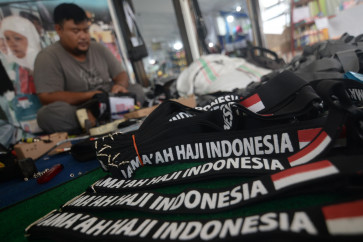'Jajan Bali' How sweet it is
Going coconuts: Klepon (little green balls of rice flour filled with palm sugar) cups are rolled in freshly grated coconut after boiling
Change text size
Gift Premium Articles
to Anyone

G
span class="caption" style="width: 496px;">Going coconuts: Klepon (little green balls of rice flour filled with palm sugar) cups are rolled in freshly grated coconut after boiling.
Come sundown, the sweets stalls at the traditional market in Gianyar attract families and friends like ants to honey ' all in search of the local treat known as Jajan Bali.
Cooked up in home kitchens, Jajan Bali is one of the few confections not yet absorbed by big industry. It comprises rice flour for body; palm sugar for a rich, caramel taste; sugi leaves for a distinctive light green color and a few pandanus leaves for an extra boost of flavor.
Jajan Bali has been the lifeblood of local families over generations. At Gianyar Market, Putu Sudarsana has just finished setting up. His stall is like a garden of color, laden with desiccated coconut klepon (green balls of rice flour filled with palm sugar) tubes of dadah, looking like tiny green sleeping bags; striped lapis in chocolate and rice colors; and his favorite: jajan lupis, triangles of sticky rice drenched in palm sugar.
The 51-year-old has been at this spot at the market for decades. 'I have been selling jajan since I was small. My parents had this stall before me, so I would come along to help.' His younger sister is the cook in the family.
On the edge of Gianyar, another family is hard at work preparing the klepon that has made them ' and their street ' famous.

On Jl. Mangku Giweng are a string of jajan kiosks that stand in front of family homes. One of the best known is belongs to Anak Agung Oka, who specialises in jajan klepon.
Her entire family is involved in the business, which she started 25 years ago, when Oka was struggling to put food on the table.
At that time, her husband, Ida Bagus Made Putra ' now a great klepon cook himself, was hunting for work in Denpasar and coming home empty handed.
'There was no work and no money. So I tried looking about for a way to feed my family and thought of making klepon here at home,' says Oka as she sits on low stool by a warming pot of melted palm sugar. She continues. 'I started teaching myself by trial and error, selling first at the market and then the business grew and grew until the point where people where coming here looking for my klepon to sell on themselves or take to ceremonies as snacks.'
Her recipe includes sticky rice flour, pandanus and sugi leaves and, surprisingly, kapor, a type of ground coral used in betelnut mixes.
Oka's 30-year-old daughter, Jero Putu Juliani, is busy preparing klepon cups that her mother will fill with the palm sugar, before plopping them into simmering water to sat and then rolling them in desiccated coconut.
'Mom uses the kapor to give the klepon cups flexibility,' Putu says. 'Without that they crack, but it takes experience to know just the right amount: Too little and they crack, too much and they crack, so it needs to be just right. Over time you get to feel just how much to put in the klepon sticky rice flour dough.'

The cups are formed almost like tiny clay pinch pots between thumb and index finger.
Putu says she makes hundreds a day to fill the demand for the family's sweets.
'Most days we prepare and sell about 10 kilograms of klepon, that is around 1000 cups. Dad helps out. He peels and grates the coconut and helps out in lots of ways,' Putu says of her father, who is
nursing his sick two-month-old granddaughter as the women process the klepon.
'I am really proud of what my mom has achieved, starting from nothing all those years ago. Next door we have family now also making klepon, so the business keeps on growing,' Putu says as she halts cup making to serve a customer who takes five boxes of fresh klepon. 'We have no machines. It's all done by hand, except we have a juicer to extract the color from the sugi leaves.'
The customer, Kadek Deni, is a big fan. 'I am buying these as souvenirs for family in Karangasem. This klepon is the best known in Gianyar. I can't go home without it.'
Putu says her mother's klepon has a strong following with holidaymakers from as far afield as Singapore and Jakarta stopping by to load up. Pinching out her tray after tray of klepon cups, Putu adds, 'I can't say our klepon is the best ' that would not be polite ' but that is what our buyers say.'


' Photos by J.B.Djwan









